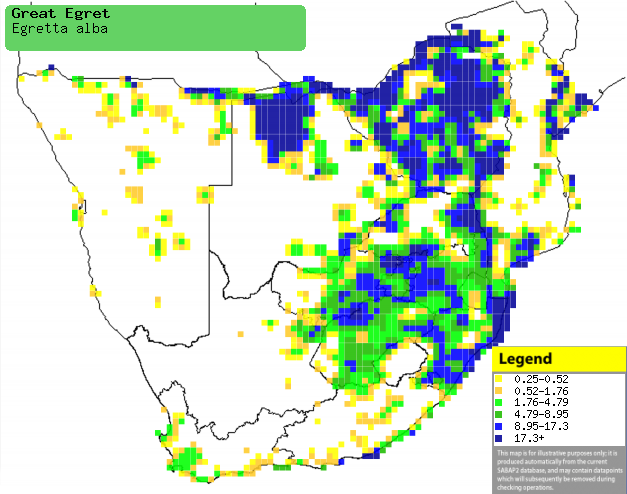|
Egretta alba (Great egret,
Great white egret)
[=Casmerodius albus]
Grootwitreier [Afrikaans]; iLanda (also applied to
Cattle egret) [Zulu]; Samunkoma gomuzera [Kwangali]; Leholosiane (generic
term for egret) [South Sotho]; Svorechena [Shona]; Grote zilverreiger
[Dutch]; Grande aigrette [French]; Silberreiher [German];
Garça-branca-grande [Portuguese]
Life
> Eukaryotes >
Opisthokonta
> Metazoa (animals) >
Bilateria >
Deuterostomia > Chordata >
Craniata > Vertebrata (vertebrates) > Gnathostomata (jawed
vertebrates) > Teleostomi (teleost fish) > Osteichthyes (bony fish) > Class:
Sarcopterygii (lobe-finned
fish) > Stegocephalia (terrestrial
vertebrates) > Tetrapoda
(four-legged vertebrates) > Reptiliomorpha > Amniota >
Reptilia (reptiles) >
Romeriida > Diapsida > Archosauromorpha > Archosauria >
Dinosauria
(dinosaurs) > Saurischia > Theropoda (bipedal predatory dinosaurs) >
Coelurosauria > Maniraptora > Aves
(birds) > Order: Ciconiiformes
> Family: Ardeidae
Distribution and habitat
Occurs in every continent except Antarctica; in southern
Africa, it is uncommon to locally common in central and southern Mozambique,
Zimbabwe, northern and eastern Botswana, the eastern half of South Africa and
the Caprivi Strip (Namibia). It generally favours shallow, open areas of
rivers, lakes, marshes, flooded grassland, flood plains, estuaries, saltpans,
sewage works and dams.
|
 |
|
Distribution of Great egret in southern Africa,
based on statistical smoothing of the records from first SA Bird Atlas
Project (©
Animal Demography unit, University of
Cape Town; smoothing by Birgit Erni and Francesca Little). Colours range
from dark blue (most common) through to yellow (least common).
See here for the latest distribution
from the SABAP2. |
Predators and parasites
It has been recorded as prey of
Aquila rapax (Tawny eagle).
Movements and migrations
Nomadic and sometimes partially migratory, as
it is a summer visitor to the Western Cape and some southern African
birds are thought to be non-breeding migrants from central Africa,
staying from late winter to early summer.
Food
It mainly eats eats fish and amphibians, doing most of its
foraging in shallow water, standing still with its body hunched and
ready to strike at any prey that comes in range. It also hunts using a technique
in which stirs its feet
or flaps its wings to disturb lurking animals, grabbing them when they try to
escape. It may even follow a Hippopotamus (Hippopotamus amphibius)
to catch animals moving away from it. The following food items have been recorded
in its diet:
- Vertebrates
- fish
- Oreochromis mossambicus (Mozambique tilapia)
- amphibians
- reptiles
- birds
- small mammals
- Insects
Breeding
- Monogamous and colonial, breeding in colonies of up to roughly 200 nests,
usually alongside other water bird species.
- The nest is built by the female with material delivered by the male,
consisting of a saucer-shaped platform of sticks and reeds, lined with
rushes and fine plant stems. It is usually placed in a reedbed or tree as
high as possible, near the centre of the colony.
- Egg-laying season is from September-March, peaking from
January-February.
- It lays 2-5 eggs, which are incubated by both sexes for roughly 24-27
days.
- The chicks are brooded and fed by both adults and are capable of weak
flight at 40 days old. They leave the colony with their parents roughly 10-20
days later.
Threats
Not threatened.
References
-
Hockey PAR, Dean WRJ and Ryan PG 2005. Roberts
- Birds of southern Africa, VIIth ed. The Trustees of the John Voelcker
Bird Book Fund, Cape Town.
|
